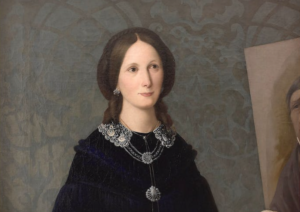‘Women Artists in Grand Tour Florence,’ Lecture in English

Women around the world are celebrated every year on March 8 for International Women’s Day. Named La Festa della Donna in Italy, the day honors women for their political, economic and social accomplishments which have brought females around the world to where they are now.
On Wednesday, March 1 at 6 pm, The British Institute of Florence will be hosting a lecture focused on female artists featured in Florentine museums through the 18th and 19th centuries. Titled A League of their Own: Women Artists in Grand Tour Florence, Jeremy Boudreau, the Head of History of Art at the Institute, will use artwork, memoirs and historic photographs to portray the important role local and foreign women had in shaping Florence into a cultural capital in the years prior to Italian Unification.
The Uffizi Gallery collection alone holds 29 self-portraits by women artists, including Anne Seymour Damer, Elisabeth Vigée-LeBrun, Louisa Grace Bartolini, Angelika Kauffmann and Elisabeth Chaplin.
The lecture at The British Institute highlights the special impact women have had on society for centuries and rightfully kicks off the celebration a week before Women’s Day, which is next Wednesday, March 8.
The creation of Women’s Day was spurred by two events that occurred in March during a significant time in history. On March 25, 1911, a factory, occupied by nearly all young female immigrant workers, caught on fire in New York City. Fire safety in the Triangle Shirtwaist factory was poor, which resulted in the death of 140 women that could not escape from the ninth floor of the building during the fire. Social protests were held afterward to raise awareness for women’s rights and unsafe working conditions. Following the Triangle Shirtwaist fire just seven years later, a group of women in Russia organized a protest that fought against food shortages and World War I on March 8, 1918.
The death of the 140 women in the fire in New York City and the Russian protesters are notable reasons March 8 was named Women’s Day. Organized by the Socialist Party of America, the first National Women’s Day, celebrated in New York City, took place in 1909. In 1911, International Women’s Day was celebrated for the first time (in Austria, Denmark, Germany and Switzerland) due to the work and determination of Clara Zetkin, a German Socialist leader.
Women join each other for meals and spend time together on Women’s Day to commemorate female achievements and progression in society throughout history. While La Festa della Donna is well-known in Italy, it was not celebrated until 1944 during World War II.
Over the years, the meaning of Women’s Day has progressed into something that focuses more on the love and appreciation people have for women, rather than being a day that is politically charged.
To attend the lecture at The British Institute that aims to educate the community about the impact of female artists in honor of the upcoming Women’s Day, please register here or send an email to bif@britishinstitute.it. To join online, click here to access the Zoom link. Registration for online attendance is not required. Participation by Zoom is free, but a donation to support the Institute is encouraged. To donate, click here. (Parker Hurley)
